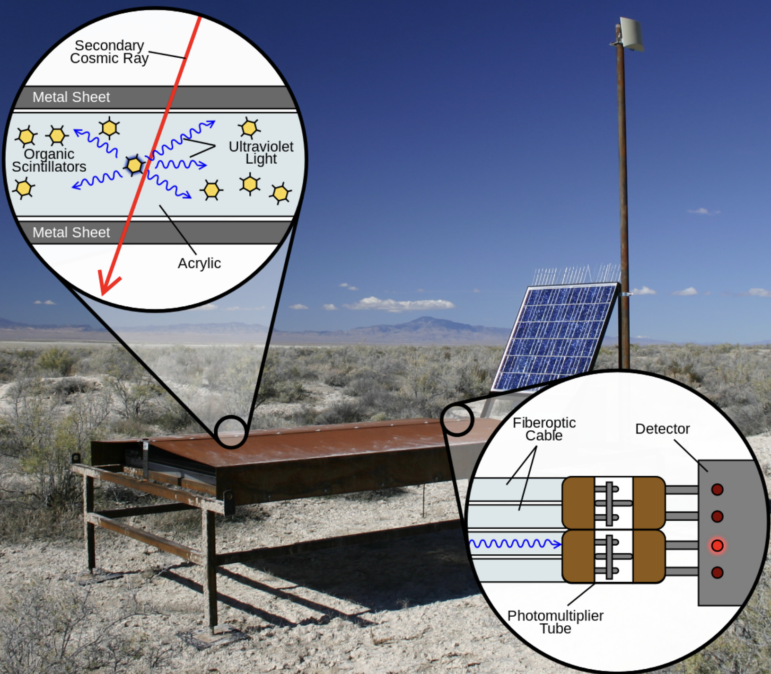
TWH – In May 2021, Toshihiro Fujii, an astronomer with Osaka Metropolitan University, was monitoring sensors at the Telescope Array, a cosmic ray detection system located in Utah, when he saw something unusual. “I thought there was some sort of mistake or bug in the software,” said Fujii, according to Nature.
The array indicated that it had picked up something incredibly energetic – a cosmic ray comparable to 1991’s “Oh-My-God” particle, which remains the most energetic cosmic ray yet detected.
Fujii and his team named the new particle “Amaterasu,” after the Japanese sun goddess. Amaterasu is one of the principal kami in the Shinto religion and is venerated at one of the largest pilgrimage sites in Shinto, Ise Jingū, the Grand Shrine of Ise, which has a traditional founding date of 4 B.C.E. She is also one of the most well-known Shinto deities, and appears in pop culture guises like the video game Ōkami and the comic book The Wicked + The Divine.

Amaterasu by Utagawa Kunisada (歌川国貞), 1856 [crop of larger artwork, public domain]
Despite the name, cosmic “rays” like the one named for Amaterasu are actually particles – usually individual protons – that travel through outer space and bombard Earth constantly.
“If you hold out your hand, one [cosmic ray] goes through the palm of your hand every second, but those are really low-energy things,” said John Matthews, a research professor at the University of Utah to CNN. “When you get out to these really high-energy [cosmic rays], it’s more like one per square kilometer per century. It’s never going through your hand.”
To be considered an “ultra-high energy particle” like Amaterasu, the cosmic ray needs to have at least one quintillion (that’s 18 zeroes!) electron volts of energy, a unit known as exa-electron volt (EeV). One single EeV is more than a million times more energy than what we have been able to produce with our most powerful particular accelerators on Earth. The Amaterasu particle, by contrast, held the energy of 240 EeVs. (The “Oh-My-God” particle from 1991 had 320 EeVs and was traveling at 99.9% of the speed of light.)
“Things that people think of as energetic, like supernova, are nowhere near energetic enough for this,” said Matthews. “You need huge amounts of energy, really high magnetic fields, to confine the particle while it gets accelerated.”
![]()
We hate to keep asking, but it is serious. Costs have hit us too.
We are grateful to our readers for your support however it manifests. Right now, we need readers who can help fund Pagan journalism to help us continue serving the community. This coverage of this story you only see here: Only TWH publishes science news from a Pagan perspective.
This is how to help:
Tax Deductible Donation | PayPal Donations | Join our Patreon
We remain one of the most widely-read news magazines within modern Paganism, and our reporters and columnists remain dedicated to a vision of journalism for and about our family of faiths.
You can also help us by sharing this message on your social media.
As always, thank you for your support of The Wild Hunt!
![]()
The Amaterasu particle brings up a number of mysteries. For one thing, it’s unclear where exactly it came from. Usually, it is relatively easy to determine the source of a high-energy cosmic ray, because they are less affected by magnetic fields than other particles. But the Amaterasu particle appears to be coming from a region of space where there are no obvious origins for the ray, to the point of even being named “the Local Void.”
“There was nothing,” says Fujii.

A photograph of one of the surface detectors of the Telescope Array in Delta, Utah with illustrations demonstrating how the equipment is activated when particles from a cosmic ray air shower pass through a sheet containing organic scintillators. These scintillators emit a photon when a particle passes by them. These photons are gathered and recorded by photomultiplier tubes. A similar illustration by the same author can be found in the Millard County Cosmic Ray Center in Delta, Utah. [ Theturnipmaster, Wikimedia Commons, CC 3.0]
There are a few possibilities for what’s going on. The most obvious- perhaps there are problems with how we currently think about cosmic rays. It’s possible that something is happening that leads these particles to travel much further than we previously thought they could – and just as likely that our model of how magnetic fields affect cosmic rays is simply off and the particle actually emanated from a different region of space.
“We think we’ve got good estimates, but maybe we’re wrong,” said Clancy James, an astronomer at Curtin University in Perth, Australia, to Nature.
Fujii and his team are currently working to increase the sensitivity of the Telescope Array by four times in order to provide better information for the next time it detects an ultra-high energy particle and to capture more particles overall.
The Wild Hunt is not responsible for links to external content.
To join a conversation on this post:
Visit our The Wild Hunt subreddit! Point your favorite browser to https://www.reddit.com/r/The_Wild_Hunt_News/, then click “JOIN”. Make sure to click the bell, too, to be notified of new articles posted to our subreddit.
